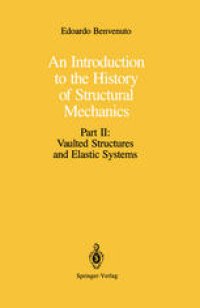
Ebook: An Introduction to the History of Structural Mechanics: Part II: Vaulted Structures and Elastic Systems
Author: Edoardo Benvenuto (auth.)
- Tags: Mechanical Engineering, Civil Engineering, Mathematics general, Theoretical Mathematical and Computational Physics, Mechanics
- Year: 1991
- Publisher: Springer-Verlag New York
- Edition: 1
- Language: English
- pdf
This book is one of the finest I have ever read. To write a foreword for· it is an honor, difficult to accept. Everyone knows that architects and master masons, long before there were mathematical theories, erected structures of astonishing originality, strength, and beauty. Many of these still stand. Were it not for our now acid atmosphere, we could expect them to stand for centuries more. We admire early architects' visible success in the distribution and balance of thrusts, and we presume that master masons had rules, perhaps held secret, that enabled them to turn architects' bold designs into reality. Everyone knows that rational theories of strength and elasticity, created centuries later, were influenced by the wondrous buildings that men of the sixteenth, seventeenth, and eighteenth centuries saw daily. Theorists know that when, at last, theories began to appear, architects distrusted them, partly because they often disregarded details of importance in actual construction, partly because nobody but a mathematician could understand the aim and func tion of a mathematical theory designed to represent an aspect of nature. This book is the first to show how statics, strength of materials, and elasticity grew alongside existing architecture with its millenial traditions, its host of successes, its ever-renewing styles, and its numerous problems of maintenance and repair. In connection with studies toward repair of the dome of St. Peter's by Poleni in 1743, on p.
This book deals with the historical development of the scientific theories that, in the 18th century, gave engineers and architects the means of calculating masonry vaulted structures, and in the 19th century provided exact mathematical methods for dimensioning the new complex structural systems which drew their origin from the Industrial Revolution. This book is written for students of strength of materials, structural mechanics (or engineering), rational mechanics, etc., who are interested in the origins of what they learn. It would be very useful, as a complementary reading, to the students of the history of architecture, history of construction and architectural restoration.
This book deals with the historical development of the scientific theories that, in the 18th century, gave engineers and architects the means of calculating masonry vaulted structures, and in the 19th century provided exact mathematical methods for dimensioning the new complex structural systems which drew their origin from the Industrial Revolution. This book is written for students of strength of materials, structural mechanics (or engineering), rational mechanics, etc., who are interested in the origins of what they learn. It would be very useful, as a complementary reading, to the students of the history of architecture, history of construction and architectural restoration.
Content:
Front Matter....Pages i-xv
Front Matter....Pages 307-307
Knowledge and Prejudice before the Eighteenth Century....Pages 309-320
First Theories about the Statics of Arches and Domes....Pages 321-348
Architectonic Debates....Pages 349-374
Later Research....Pages 375-437
Front Matter....Pages 439-439
The Eighteenth-century Debate on the Supports Problem....Pages 441-460
The Path Towards Energetical Principles....Pages 461-491
The Discovery of General Methods for the Calculation of Elastic Systems....Pages 492-512
From the Theory of Elastic Systems to Structural Engineering....Pages 513-543
Back Matter....Pages 544-554
This book deals with the historical development of the scientific theories that, in the 18th century, gave engineers and architects the means of calculating masonry vaulted structures, and in the 19th century provided exact mathematical methods for dimensioning the new complex structural systems which drew their origin from the Industrial Revolution. This book is written for students of strength of materials, structural mechanics (or engineering), rational mechanics, etc., who are interested in the origins of what they learn. It would be very useful, as a complementary reading, to the students of the history of architecture, history of construction and architectural restoration.
Content:
Front Matter....Pages i-xv
Front Matter....Pages 307-307
Knowledge and Prejudice before the Eighteenth Century....Pages 309-320
First Theories about the Statics of Arches and Domes....Pages 321-348
Architectonic Debates....Pages 349-374
Later Research....Pages 375-437
Front Matter....Pages 439-439
The Eighteenth-century Debate on the Supports Problem....Pages 441-460
The Path Towards Energetical Principles....Pages 461-491
The Discovery of General Methods for the Calculation of Elastic Systems....Pages 492-512
From the Theory of Elastic Systems to Structural Engineering....Pages 513-543
Back Matter....Pages 544-554
....